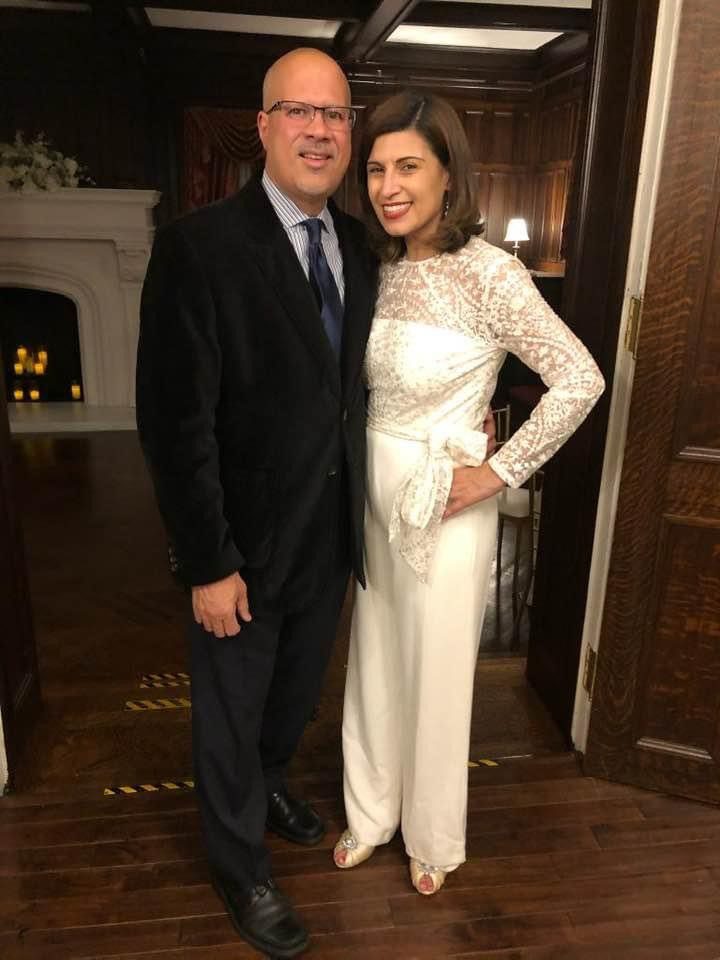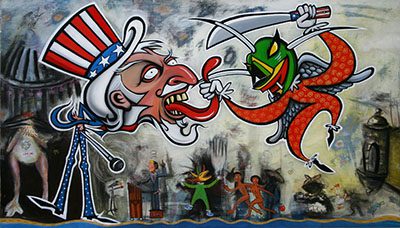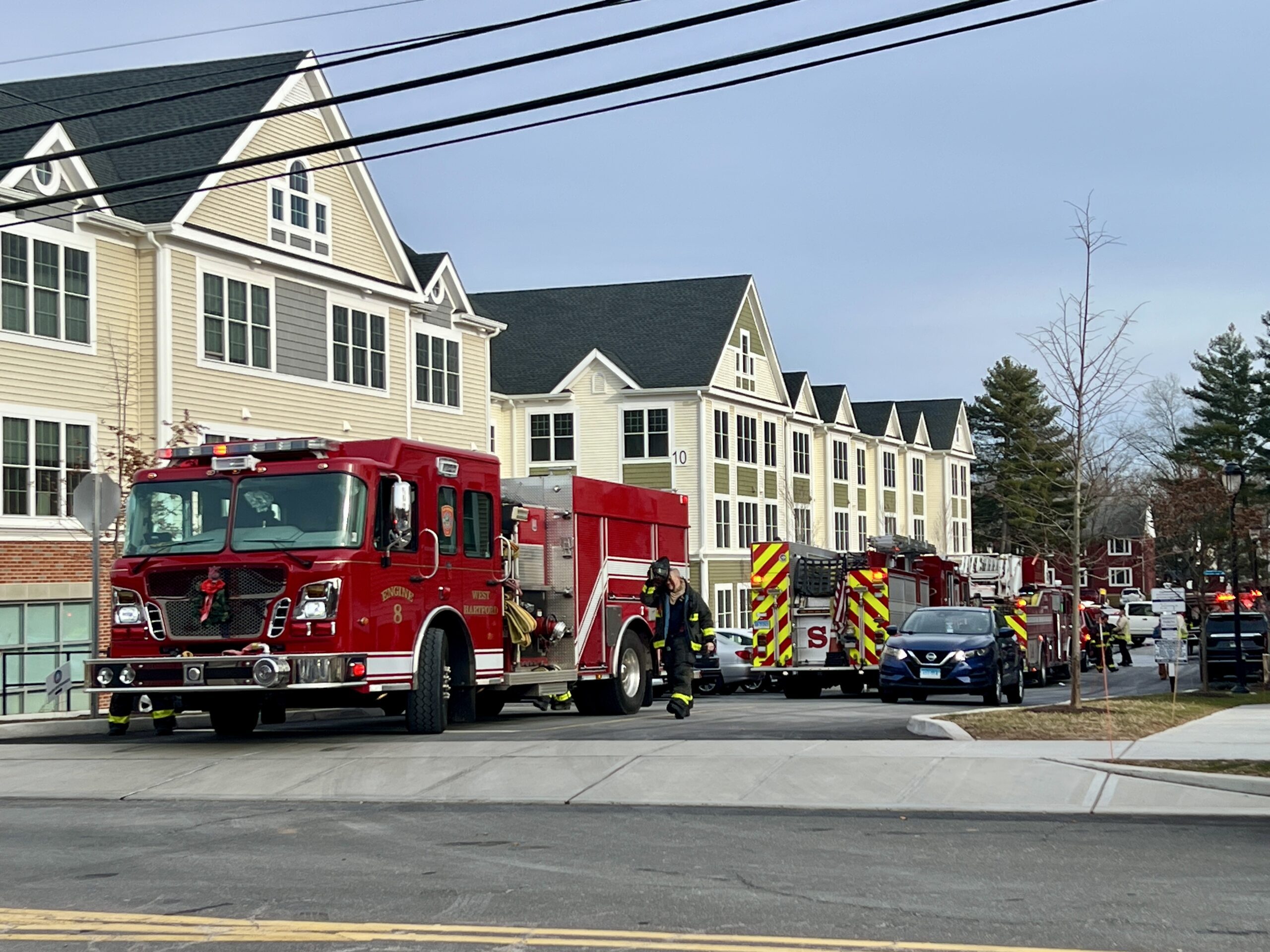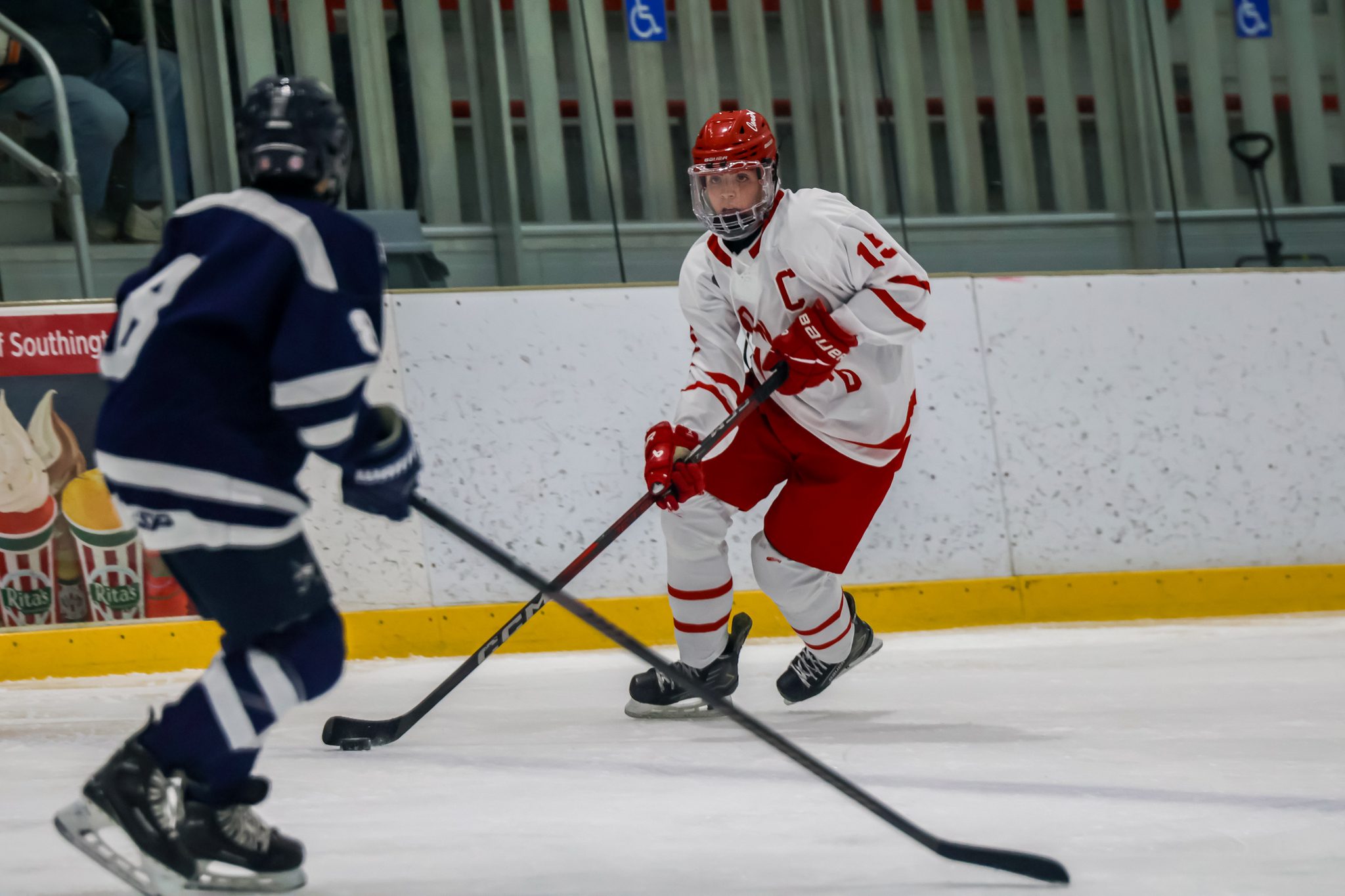Professors Loan Painting to Exhibition of Contemporary Puerto Rican Art at the Art Museum at University of Saint Joseph

Audio By Carbonatix

Dr. Anthony De Jesús and Dr. Madeline Perez De Jesús. Courtesy photo
‘(R)evolution: Identity and Power in Puerto Rican and Diasporican Art’ to be held from March 22 through June 8 at the University of Saint Joseph in West Hartford.
Submitted
Anthony De Jesús has long been a fan of the artist Miguel Luciano, whose works explore history, social justice, and the relationship between his ancestral home of Puerto Rico and the United States through sculpture, painting, art installations and activist art projects.
“Luciano is really creative and ingenious in making connections – taking what we might call ‘macro and micro-aggressions’ that are reflected in popular or institutional culture, and making a piece of art that is critiquing that or kind of turning it on its head,” said De Jesús M.S.W., Ed.D., Ed.M., and associate professor of Social Work and Equitable Community Practice at USJ.
Dr. De Jesús and his wife, Dr. Madeline Perez De Jesús, Ph.D., M.Phil., M.S.W. and USJ associate professor of Social Work and Equitable Community Practice, appreciated Luciano’s painting Como se dice Boricua en Inglés so much, it was one of the first major purchases they made as a couple.

Como se dice Boricua en Inglés (1998). Courtesy photo
“We knew this art piece would be a major conversation starter in our home,” said Dr. Perez De Jesús. We use it to invite our guests to reflect on the migration journeys and conditions of their ancestors, regardless of their cultural background. We are honored to have had the opportunity to support Miguel Luciano as an artist and to own an original piece of his work.”
Now the Drs. De Jesús and Perez De Jesús have loaned this piece of art to the exhibition “(R)evolution: Identity and Power in Puerto Rican and Diasporican Art” to be held at The Art Museum at the University of Saint Joseph (USJ) from March 22 through June 8.
The exhibition – a reflection on colonialism and Puerto Rican resistance – opened with a public reception on Friday, March 22. Other featured artists include Antonio Martorell, Juan Sánchez, Pablo Delano, Allora & Calzadilla, Yasmín Hernández, Marta Mabel Pérez, Danielle De Jesus, ADÁL, Omar Velázquez, and Ernest Lopez. Miguel Luciano himself will deliver an artist talk on Tuesday, April 23 at 7 p.m. at USJ’s Hoffman Auditorium in Bruyette Athenaeum.
“This exhibition recognizes the quest for political, linguistic, cultural, and economic parity of the Puerto Rican people,” said De Jesús.
“Since 1898, Puerto Ricans have utilized political organizing, protest, and revolt to resist the subordination of their identities within the U.S. and confront man-made and natural disasters. At the same time, this resistance has shaped the identities of generations of Puerto Ricans born and raised stateside within the context of an evolving cooperative/complex relationship between the island/archipelago and diaspora.”
The exhibition and Luciano’s talk will be held in conjunction with additional programming exploring Puerto Rican culture, including “Noche Boricua! A celebration of Puerto Rican Music and Dance” – an evening of Puerto Rican music and dance featuring William Cepeda’s Puerto Rican Explosion on April 13, 7:30-9:30 p.m. in USJ’s Hoffman Auditorium. This event will be preceded by a reception with light refreshments, beginning at 6:30 p.m.
Earlier that day a Bomba/Plena Family Workshop with Cepeda, a four-time Grammy nominee, will be held at the Art Museum from 1-4 p.m. And on Saturday, April 27 at 11 a.m., the Art Museum will welcome families to an event featuring nature- and museum-based activities inspired by (R)evolution: Identity and Power in Puerto Rican and Diasporican Art and University of Saint Joseph’s Earth Festival.
The idea for this exhibition began several years ago when De Jesus showed Cómo se dice Boricua en Inglés to Ann Sievers and offered to loan it to the Museum.
“Several years ago, I began to discuss a potential exhibition with Tony that would center around Miguel’s painting and bring other pieces that could expand upon Miguel’s themes,” said Ann Sievers, director of the Art Museum and the exhibition’s curator. “Because while I am not a scholar of Puerto Rican art, I wanted to invite a range of authoritative scholarly voices to write wall labels for works in the exhibition. In the selection of these contributors and in the planning of exhibition-related programming, Tony was a major contributor of contacts, suggestions, and arrangements.
“The Art Museum has taken over the organization of Noche Latina – and this year we decided to delay it from October to April so that “Noche Boricua” could coincide with (R)evolution,” Sievers added. Noche Boricua is supported in part by the NEH Humanities and Arts Fund at the University of Saint Joseph and the Vincenza A. Uccello ’56 Lecture Fund.
Miguel Luciano created Cómo se dice Boricua en Inglés (1998), in response to the centennial of the U.S. annexation of Puerto Rico following the Spanish-American War.
(The word Boricua is derived from Boriquen, the Taino word for what is now known as Puerto Rico or what the indigenous people of the island and much of the Caribbean called “The Land of the Brave Lords” said De Jesus. Thus, translated into English the name of the painting is “How Do You say Boricua in English?”)
The painting features a machete-wielding vejigante, the demon/trickster figure associated with the Loiza Aldea festival of Santiago Apostôl, confronting Uncle Sam, alluding, together with smaller vignettes, to themes of suppression of native language and culture, economic colonialism, and racial and ethnic stereotypes and hierarchies.
“It had been part of a series of paintings Miguel produced in 1998 commemorating the 100th anniversary of the Spanish-American War. In this piece he is reacting especially to the portrayal of Uncle Sam in some early political cartoons in Harper’s Weekly and other publications where Uncle Sam was shown as this paternalistic figure surveying these recent acquisitions in 1898 – Cuba, the Philippines, Puerto Rico, Northern Mariana Islands, Hawaii,” said De Jesús. “Those are some of the themes he is also responding to and critiquing in Como se dice Boricua en Inglés. That is a common theme across much of Miguel’s work.”
De Jesús was serving as a graduate student research associate and eventually interim director of the Center for Puerto Rican Studies in New York, when he came to know Luciano, who was at the time working on “Louisiana Porto Ricans,” a series of paintings that reinterpret produce labels published during the 1930s-1940s. The original labels advertised different brands of “Porto Rican yams and sweet potatoes and formed some of the earliest representations of Puerto Ricans in the United States.
In the mid 2000s De Jesús and Perez purchased Luciano’s painting Cómo se dice Boricua en Inglés.
“Tony and I are both proud Nuyoricans – Puerto Ricans who were born and raised in New York City,” Perez De Jesús explained. “While we have much in common due to our background, there are distinctions that emerge from the different ages and conditions surrounding our parents’migration to the U.S. [Perez De Jesús’ parents came to the U.S. via air travel as adults while De Jesús’ parents came to the U.S. via ship when they were children.] This impacts differences such as the dominant language in our home, our families’ ability to navigate institutions, and their own relationship to the island. Our marriage displays two different examples of the Puerto Rican Diaspora and this painting showcases that and so many others.”
De Jesús says that Luciano’s works speak to him and his struggle with his Puerto Rican and U.S. “American” identities.
“I was born in New York. My parents were born in Puerto Rico and as a young person growing up in New York City, I knew that there was something unique about Puerto Rican identity. I knew that there was also some stigma about Puerto Rican identity… I knew that there were differences, but I didn’t understand them fully,” said De Jesús. “There were aspects of that that I understood and other aspects that did not understand or rejected as part of my own American identity. I had lots of questions.”
De Jesús says that Puerto Rican poetry and art, like Miguel Luciano’s, have helped him to “make sense of my own experiences, the experiences of others, and to transcend those experiences and not allow them to hold me back. I think that Miguel’s work represents my ability to have navigated those forces, and my own interest in sharing that with others.”
Sharing Cómo se dice Boricua en Inglés is a way to not only expose the public to works of Luciano and other Puerto Rican artists, but also to help educate the public about the history, richness, and strength of the Puerto Rican community.
“USJ is always exploring ways to enact our commitment to our values of understanding multicultural/diversity and ‘developing the whole person,’” said Perez De Jesús. “The annual Noche Latina concert, the offering of the general education course Latinas and their Worlds are two such examples of exposing our students to Latino culture. The (R)evolution exhibit is a natural extension of this foundation that includes the larger community. My hope is that those who attend the exhibit will see the art piece as a way to gain a deeper understanding of the complex relationship between the United States and Puerto Rico, especially since Hartford is home to the eighth largest population of Puerto Ricans in the United States.”
For more information about this event and other exhibition-related programming, see www.usj.edu/artmuseum/revolution. For tickets go to: Art Museum, University of Saint Joseph Events – 4 Upcoming Activities and Tickets | Eventbrite
The Art Museum at USJ’s public hours are Wednesday through Saturday: 11 a.m.-4 p.m.; closed Monday, Tuesday, and Sunday. Admission is free. For more information, visit www.usj.edu/artmuseum.



